“If you’ve sailed enough, you’ve either been aground, will be aground, or you’re lying”… began the somewhat intimidating briefing before we stepped aboard our first solo chartered sailboat. At the time both of us shook it off as the charter company being extra cautious – little did we know! Note that this post is primarily concerned with shifting sandbars, minor groundings that are annoyances, but not more serious grounding situations where boats wash ashore on beaches, rocky shorelines or reefs.
Since we bought Winterlude, luckily, we’ve never been seriously stuck aground that we couldn’t get ourselves off — of course, when you cruise outside the USA, you pretty much have to stay off the reefs or risk huge fines or losing your boat, and there’s not as much risk of a soft grounding.

Back in Southwest Florida and the Bahamas, there’s much more risk of a soft grounding — defined as being stuck on sand or whatever, but no damage to the boat and no risk of damage to the boat when being towed off. Now that we’re back in US waters, we added towing insurance immediately — not only will they help if you happen to get yourself soft grounded, but they’ve also been known to bring us replacement alternator belts etc. It’s apparently less expensive for a towing service to bring you a part (you pay for the part) than to tow you back somewhere. Here’s my post on tips to navigate the SeaTow Towboat US maze if you’re confused (we were!).
But back to being aground …. with our 5 1/2 foot draft and the shallow sand bottomed Southwest Florida waters, we’ve bumped more than a few times, the most serious being last winter going into Newfound Harbor in the Florida Keys (see post here).
It seems easy – you won’t run aground if you keep your boat in deep water. But what about the ever shifting sandbars or heaven forbid, an engine that sputters and dies? Not to worry, there are lots of things to try before calling a towing service!
1. First, do NOT try revving the diesel or engine — if you’re in shallow enough water (and you probably are if you’re stuck), all you’ll do is stir up the bottom making all that stirred up sand or mud go into your engine intake and clog up the engine. Mud or sand in the engine intake can cause your engine to overheat … or worse. A complication you simply do not need if you’re already aground. Talk about a good way of increasing the decibel levels of whatever curse words are being bantered around aboard!
Even if you think you can “back off” easily, there’s a good chance you’ll just drive the boat further aground by traveling farther into shallow waters.
2. Do NOT panic. Panicked action usually causes the situation to be worse, not better.
3. If you’re sailing, tack and move everyone aboard to the leeward side of the boat. If that doesn’t work, immediately drop the sails so you don’t sail into even shallower waters.
If you’re motoring, instead of revving the engine, STOP! Totally stop the boat.
In either case, access the situation. Check for damage, leaks and injuries. Checking the bilge is always a good place to start. Put on life jackets if there’s any risk of boat or life.
Evaluate your rudder & keel configuration – spade (i.e. freestanding) rudders are at risk of being bent or worse in any grounding situation. Make sure you understand the impact of what you plan to do on your rudder and keel.
Next, you need to know where the deeper water lays so you can figure out how to get yourself off.
4. If you don’t already know, consult your charts. You need to be aware of the type of bottom – is it mud, sand or something hard like rock or coral? Obviously rock and coral could cause a soft grounding to become a hard grounding (loosely defined as a grounding with a risk of puncturing the hull) and you don’t want to make matters worse.

5. Find out what the state of the tide is … if it’s low tide, you may be able to simply wait for a higher tide to float you off with no problem. This worked well for us when we were aground in Factory Bay, Marco Island because we didn’t realize the full moon tide swing was much greater than normal – be aware of local factors involving tides ahead of anchoring with just a few inches of clearance under a 5 1/2 foot keel! 🙂 When the tide went out 4 feet, we were left tipped slightly to one side on our full keel, needless to say, we didn’t get much sleep anxiously awaiting high tide just before sunrise – when we upped anchor, went out the way we came in and happily sailed away.
6. While you access the situation, it may be a good idea to drop an anchor … just in case you’d happen to drift into even shallower water. Be sure to retrieve the anchor once you’ve figured out your strategy — it probably wouldn’t have worked had we continued to step 7 without retrieving our anchor! Luckily in this case, we didn’t need it because we could easily see deeper water just ahead.
6. If the bottom is sand or mud, there are some actions you can take that may help without damaging the boat. First try to point the boat toward deeper water. In many cases you can see deeper water by just being aware of the deeper shades of blue. Deep blue is usually deep water, clear greenish-aqua is shallow and brown or white is VERY shallow. If we can’t visually see deeper water, we can launch a kayak with a handheld depthsounder.

7. Once we know where deeper water is – in the Newfound Harbor case of the shifting sandbar, it was directly ahead. With the wind gusting over 17 from just forward of abeam, we pulled out the jib to try and heel the boat, thus freeing our 5 1/2 foot cutaway full keel from the sand/mud trying to suck us in. In this situation, this tactic worked. Our next step would have been to put up the main to try and increase the heel of the boat.
8. If there’s no wind, anything you can do to make the boat lean to one side may free it if you’re just lightly aground. We’ve known boats to put the boom all the way out to a side and have people climb out on it … not something I’d be anxious to try but it might be worthwhile. We’ve also known boats aground on the sandbar covering the Rio Dulce River entrance in Guatemala to hire a local panga (large heavy runabout) to tip the boat pulling a halyard from the top of the mast.
9. The next step is to learn to kedge the boat by placing the anchor a ways away in deep water, usually with a dinghy, and pulling the bow toward the deeper water, then inching the boat forward a bit at a time by pulling on the kedge. Place an anchor in the dinghy – we use our fortress because it’s oversize, but aluminum which means it provides terrific holding power, but those sharp tips can easily ruin our dinghy’s day (and ours!). Plan on at least 3:1 scope, so have enough line/chain in the dinghy to pay out to set the anchor. Don’t just dump the anchor into the water, use the dinghy to try and get it to set before moving it to the boat – this is easier said than done, and again, one of the reasons we use our aluminum oversize Fortress anchor for this job.
Next you’ll need to transfer and connect the rode to a winch on the boat – preferably the largest winch with the most purchase, usually located in the cockpit. NOT your windlass! Whatever you do, don’t burn out your windlass! Windlasses are not made to take the load that you’ll be using if you’re trying to manually pull the boat forward into deeper water. Normally you’ll use the kedge to get the bow pointed toward deeper water and then literally inch it forward cranking a bit at a time on the winch to bring in the anchor rode. We’ve heard of boats running the main halyard from the top of the mast to the anchor line and cranking on the halyard line to heel the boat over. This is similar to the boats in the Rio Dulce having a panga pull over their main halyard, but it seems pretty scary. We’ve not done it, so I cannot comment on how to do it, just that others have done it.
10. Still stuck? Last resort, if you’re in US waters, call your towing service. See my post Navigating the Towing Service Maze if you haven’t purchased towing insurance yet – it’s one of the cheapest values available!
If you’re not in US waters, you’ll have to try something else. If you dive the boat and find that it’s only hung up by a little, you might be able to lighten the boat by dumping the water tanks – each gallon of water weighs approximately 8.3 pounds, so if you dump 10 gallons, you’ve dumped 83 pounds of weight. Unfortunately as cruising boats go, that may not be even a drop in the bucket. But it’s a thought. If I jump overboard, we’ll gain more than that … not that I’m volunteering to jump overboard….
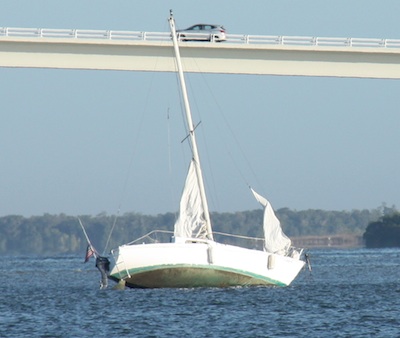
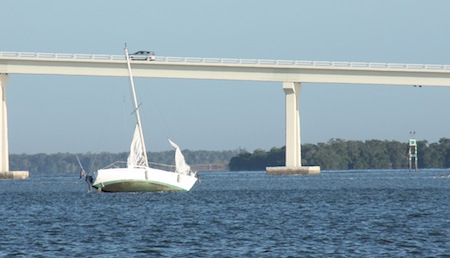
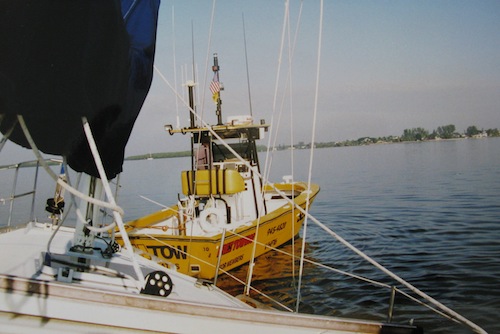










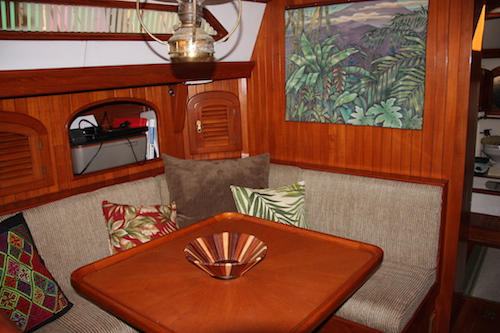

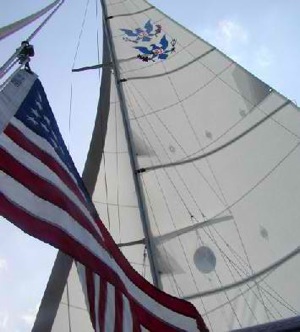
It is really hard to think super clearly the first time you get stuck. My first instinct was to rev my engine and try and back out. It didn’t work, and I did a number on my engine. I eventually had to get towed out. Anyway, I do appreciate your tips. Next time I get stuck I won’t panic, and I’ll get out.
I really want to sail, but I don’t know how. I wanted to look up some tips and tricks before going out on the water, so thanks for the advice. I never would have thought that revving the engine would make things worse by kicking up sand and mud, so thanks!